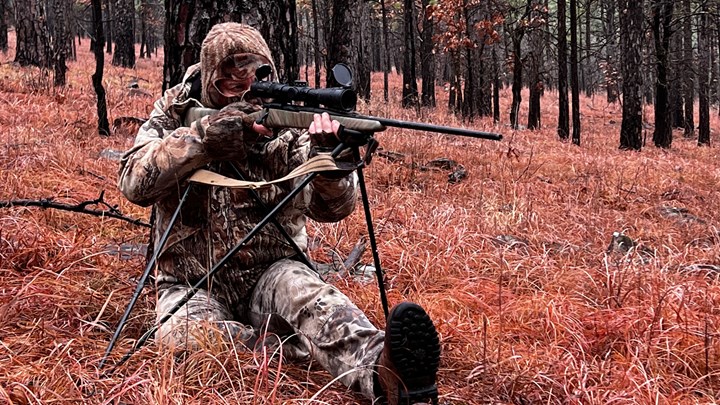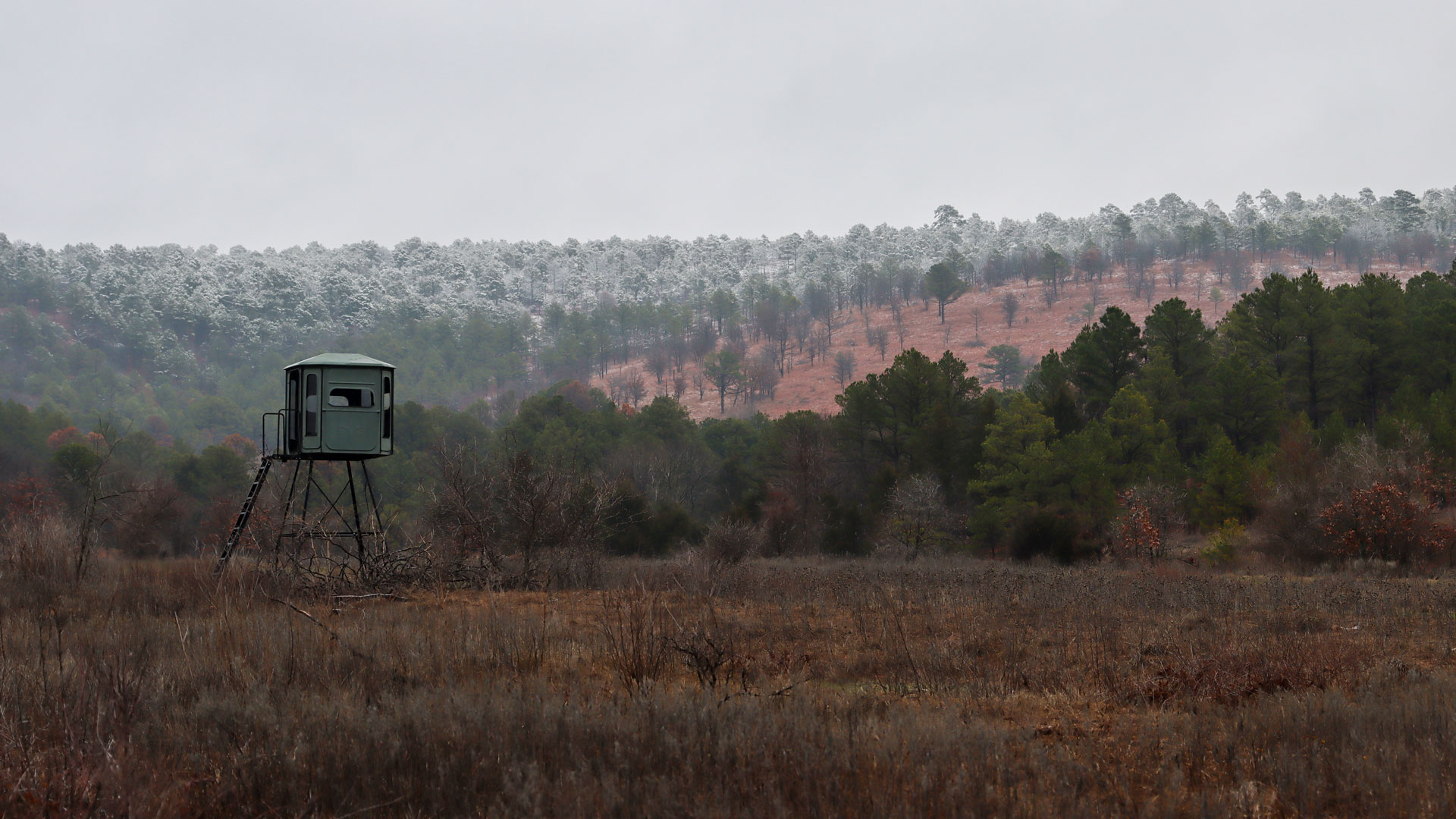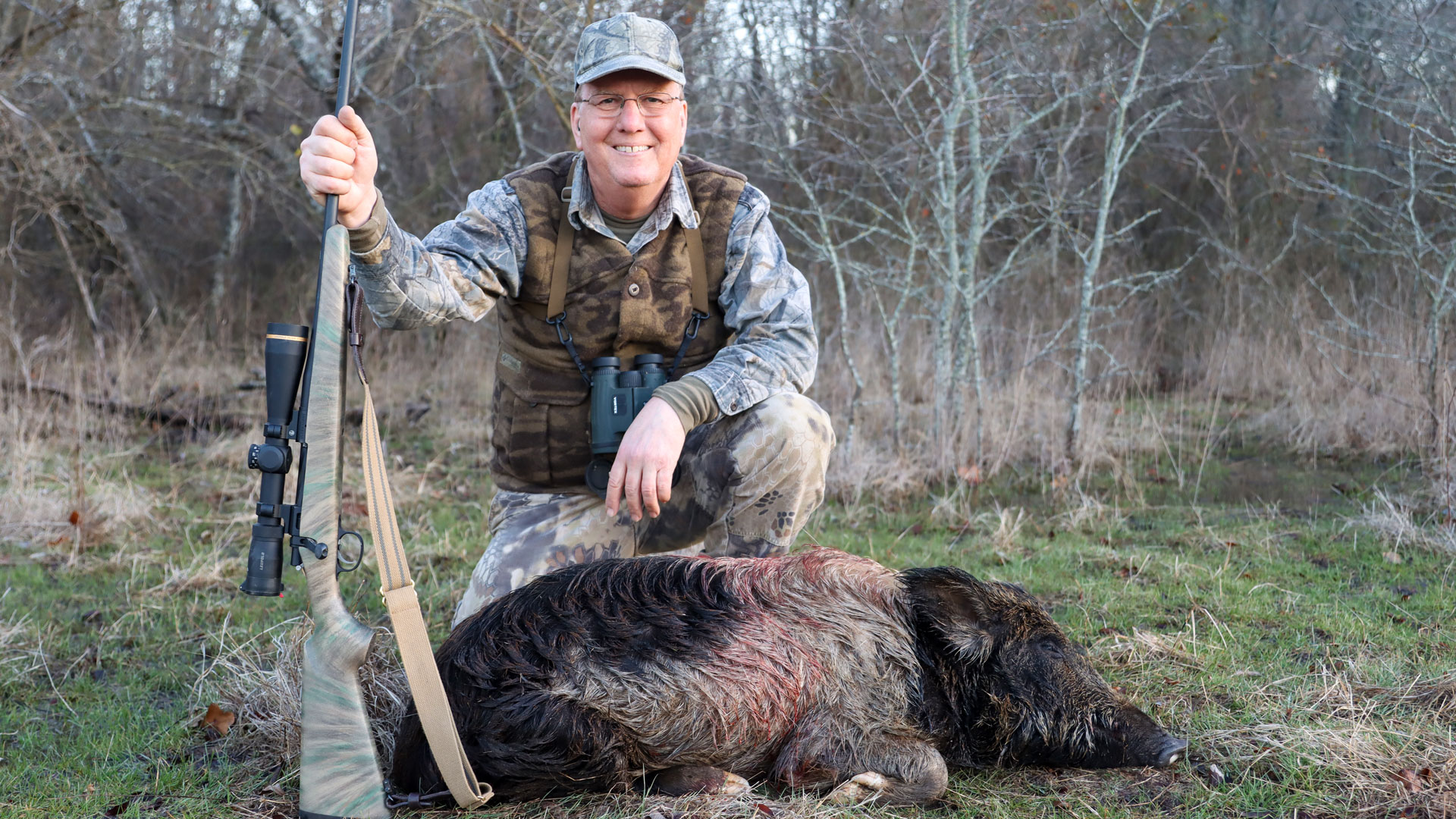
by Mike Arnold - Thursday, August 24, 2023

Discouraged was a mild word for how I felt. My outfitter, Eric Selph, and I had spent two and a half days calling for predators, spotting and stalking, and waiting on stands over feeders for feral hogs. Nada.
While I loved seeing the hunting property bordering on the beautiful mountain range known as Kiamichi, or “noisy bird” by members of the Choctaw Nation, our difficulties began when more than a tenth of the annual 60 inches of rainfall decided to meet me as I drove from the Tulsa airport to the hunting lodge. Torrential rain kept the animals bedded for the first two-and-half days, then that afternoon, a heavy snowstorm dumped 5 inches of snow on the countryside, the deer I watched and me as I sat on a stand near one of Eric’s 27 feeders waiting for a hog to show.
Over the first three quarters of my hunt, Eric and I jumped exactly two hogs as we slipped and slid our way along the greasy roads and up and down the rock-strewn slopes. And we called in zero predators from the two “sets” along the scenic hillsides, though we did bust a hog from its bed at the second site that gave me no chance of a shot as it tore through the thicket. So, as we sat in the restaurant called Reba’s Place, named for its owner, country music star and actress Reba McEntire, I faced the possibility of leaving this spot in southeastern Oklahoma near a place known as Limestone Gap empty-handed. I kept reminding myself that the possibility of failing to take our quarry was why we sportsmen and women called it hunting rather than shooting. Right then, I was having a hard time appreciating that fact.
In the past a thriving community, Limestone Gap now had a population of exactly one—my outfitter and guide, Eric. He established his hunting lodge in a former sale barn used to transfer registered bulls and cows between ranchers. It contained a full-sized tractor, an assortment of equipment and bags of corn for the many feeders scattered over the 4,500-acre lease.
On the first afternoon, after making sure my MG Arms Ultralight was still zeroed after passing through multiple baggage handlers, we climbed into Eric’s F-150 and headed to the ranch. We immediately began jumping whitetail does and recently shed bucks from the brushy draws and food plots. I always love seeing whitetails, but I wasn’t there for that species, and the only individual belonging to a species of interest—a jet-black feral boar—scrambled over a ridgeline before I could crawl out of the pickup. We wound our way back to the lodge for dinner and bed. I wondered if the rain, the first after a multi-month dry spell, might have come too late for hunting drought-sensitive hogs and predators.
The second day of my hunt dawned cold and overcast. The below-freezing temperature did not bode well for seeing hogs but might make predators more willing to come to the sounds from the Primos Alpha Dogg electronic caller. This time we left Eric’s F-150 behind and loaded into his open-air Polaris RZR four-wheel-drive buggy. I made the mistake of not bundling up, and the morning of driving, walking and sitting at our two predator sets was a bone-chilling experience. Our second hog sighting of the trip came as we worked down a ridge toward a set for predator calling. Bursting from its bed, a big, dark pig raced into the surrounding stand of trees. I wasn’t quick enough to get off a shot. Just before this close encounter we walked past a huge wallow. After watching the boar streak into the forest, I couldn’t help but worry that the cards would never fall into the right order for collecting a hog.
The second predator set looked perfect like the first as we looked over a stream bottom and into the tree line across the clearing. The caller belted out a series of rabbit screams, coyote howls and distressed pup cries. We sat and watched for 25 minutes to no avail, but we did have a predator visitation. About 30 seconds into Eric’s series of calls, a prairie hawk swooped toward the rabbit noises, landing in a tree just above the electronic caller. I could almost imagine a disgusted sigh as it took wing after figuring out there was no dying rabbit.
Around noon we headed back to the lodge for lunch and hot coffee. The afternoon plan involved my sitting on a stand where Eric’s trail cams and scouting indicated activity by not only whitetail and turkey but also feral hogs. Dropped off at 2 pm, I settled into the comfortable tree stand and waited. At exactly 4 p.m. the feeder mechanism activated, spraying a shower of corn. Fifteen minutes later, as predicted by Eric, the first whitetail deer appeared. Over the next hour and a half, eight more deer appeared, but not before the heaviest snowstorm I’ve ever experienced dropped 4 inches of soft, wet, huge flakes. Fortunately, I’d learned my lesson from the morning and had on many layers. Though I stayed warm, the lack of hog activity was disheartening as I thought, Weather 2, Hunters 0.

The next morning, I was still feeling the effects of overeating during another fantastic dinner at Reba’s Place. Downing a piece of toast and two cups of coffee, I readied myself for the bitter cold weather and we climbed into the Polaris, this time with me wearing most of the warm clothes I’d packed. As we drove, the distant trees and ground glistened with snow and ice. Eric headed to a different area on the edge of the ranch, this one tucked into the base of the mountains. We headed up the steep incline, Eric easily, me trying not to bring up a lung. A mile later, Eric chose a spot for the caller while I unloaded my pack.
Eric shuffled a series of calls through his Primos electronics, then after 25 minutes, he went silent. I heard the slight noise indicating he was getting to his feet. As I reached for my pack, he appeared at my side and said, “I don’t know why, but I’ve never called in a predator on this ranch—coyote or bobcat—before 10 a.m.” As I prepared to stand, I glanced at my iPhone and noticed that it was 10:03 a.m. Suddenly, Eric squatted down and whispered, “There are two coyotes right there.”
“Right there” was just over a slope that hid the two animals from my sight. I froze and waited while Eric released the distressed pup noise from the caller, hoping to bring them closer. The coyotes took flight, but Eric continued calling. “There is a third dog,” he whispered, as it weaved through the dense stand of trees to our right. I followed it in the Leupold scope. It entered a coyote-sized gap and I squeezed off a round.
“My first coyote!” I exclaimed, looking at the beautiful animal. We spent the rest of the morning taking photographs and then climbing up and down the slopes of the Kiamichi mountains, waiting at three more sets, though no more coyotes appeared.
Around 1 p.m., we broke off our predator hunt for my last attempt at a feral hog. Eric drove us to a ground blind near a food plot with a feeder that, according to his trail cam, was regularly tipped over by a large black boar. After tipping the unit upright, we dipped out the rain-drenched corn and refilled it. Eric drove me across the food plot to the blind and instructed me to shut all the windows except the one facing the feeder. I said I would do my best to rid him of the offending animal.
As Eric disappeared in a shower of muddy water kicked up by the Polaris’ tires, I pulled my rangefinding binocular to my eyes, smirking when I saw “78.3 yds” appear in its field of view. When I asked the distance to the feeder moments earlier, he’d estimated 80 yards. I’d have to give him heck about being wrong when he picked me up later.
I settled into the blind knowing the feeder would spray corn at 4 p.m. At 4:45 p.m., the first feral hogs I’d seen since the one we’d busted from its bed the day before appeared. But instead of the expected solo feeder-tipper, a herd of 20-plus pigs from piglets to large sows charged into the area. I waited, hoping to spot a boar, but Eric’s last comment was, “Shoot the largest pig that appears, even if it’s not the boar from the trail cam.” I spotted a large sow with swollen teats. As a biologist, I knew that taking a female had a better chance of impacting the population growth of this invasive, super-destructive, species. I fired and heard the din of squealing coming from the rapidly disappearing herd.
As I approached the sow, I realized her coloration resembled that of domesticated Hampshire animals, featuring the breed’s beautiful black and white markings. I estimated her weight at 100 pounds. I texted Eric with the simple message, “You can come collect me.” He texted back asking, “Did you get him?” My reply was, “No, I’ll explain when you arrive.”

Eric was surprised that I’d seen a herd rather than the boar, but he was pleased that I’d removed a big sow, reinforcing the critical role that hunting plays in wildlife management. We took a few photographs, loaded her onto the back of the buggy and headed for the lodge. We stopped for photographs of two fascinating historical sites. The first was the Limestone Gap school, established in the 1930s and sadly largely destroyed by a brush fire. The second was a trapper’s cabin from the same era. Both buildings were reminders of the resolute and self-sufficient former residents of Limestone Gap and underscored the hard-scrabble existence demanded from those who chose this area as home.
As we drove to the lodge, I reflected on the beauty of this piece of North America, the United States and Oklahoma. There were many significant memories taken from this trip, including my first coyote and only my second feral hog. Yet of equal significance were the memories of enduring the uncompromising weather and terrain required for a successful hunt for predators and pigs near Reba’s Place.
About the Author
Mike Arnold is a professor of genetics at the University of Georgia and author of the 2022 book Bringing Back the Lions: International Hunters, Local Tribespeople and the Miraculous Rescue of a Doomed Ecosystem in Mozambique. Mike’s book is available for purchase by clicking here.
E-mail your comments/questions about this site to:
[email protected]
Proudly supported by The NRA Foundation and Friends of NRA fundraising.
